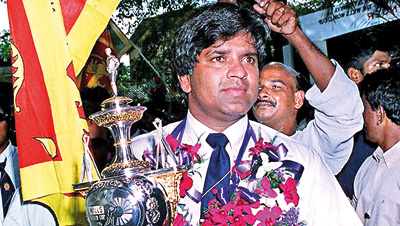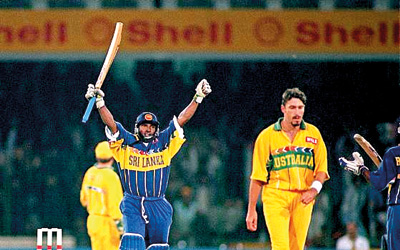Then it was the best of times, but now, the worst of times
View(s):
 Today, exactly 23 years ago, on March 17, 1996, Sri Lanka cricket zoomed to the top of the cricket world, winning the 1996 ICC World Cup, when the islanders, led by Arjuna Ranatunga, trounced Australia by 7 wickets in the final in Lahore.
Today, exactly 23 years ago, on March 17, 1996, Sri Lanka cricket zoomed to the top of the cricket world, winning the 1996 ICC World Cup, when the islanders, led by Arjuna Ranatunga, trounced Australia by 7 wickets in the final in Lahore.
As the famed English author Charles Dickens penned at the beginning of his classic tome, the ‘Tale of Two Cities’: “It was the best of times and the worst of times……” If the writer may parody those lines, it was the best of times – in 1996 – but now, the worst of times. Of course, Sri Lanka won both Test matches in South Africa but, with the focus on the forthcoming World Cup, being smothered in the 1st 4 ODIs by the Proteas, it seems, no punter would wager his/her money on Sri Lanka!
It was a case of coming from behind, to be crowned World Champions, 23 years ago. Until 1996, Sri Lanka had lost the most number of World Cup matches (20 in 26 games) and ended comfortably, either at the bottom of the heap or, at one but the last, on each of the 5 previous occasions.
The only previous occasion when Sri Lanka was able to hold its head high was in 1979, when still, as an Associate Member of the ICC, Sri Lanka beat India. This was the 1st occasion when an Associate Member beat a Full Member of the ICC in the World Cup competition.
In other words, for a nation with a track record such as this, to become World Champions without losing a single game in the tournament, borders on the impossible. Must have made Bob Ripley turn in his grave!
Just a matter of 15 years earlier, in 1981, Sri Lanka was awarded Full Membership of the ICC. And to leapfrog into the world sporting headlines – when some may not even have been aware of the existence of the island, except, think that Sri Lanka was a part of India!
It was also not merely winning the title, but how Sri Lanka crushed all opposition, in a manner no previous champion (yes, not even the West Indies under Clive Lloyd in 1975 and 1979, had done so) is the icing on the cake. This victory was something no politician no diplomat ever achieved in putting Sri Lanka on the world map.
Just look at the Statistics:
Firstly, Sri Lanka won all their matches. Then, so did the West Indies, when they won the crown at the inaugural World Cup in 1975.
Of course, Sri Lanka earned 2 points without setting a foot on the field, when Australia, citing safety/security issues, refused to visit Sri Lanka, and the West Indies followed suit.
Then the puny Kenyans humbled the mighty West Indians by 73 runs and came to Sri Lanka for the next round at Asgiriya. The Kenyans were in for a big surprise. The Sri Lanka openers, Sanath Jayasuriya (44) and Kaluwitharana (33) started proceedings by blitzing 83 runs in 6.3 overs and the mayhem continued with Aravinda (145), Gurusinha (84), skipper Arjuna (75*) that eventually helped Sri Lanka amass 398/5 – the highest ever total in ODI cricket up to that time. Next, Zimbawe was simply rolled over with Gurusinha (87 in 100 balls) including 6 sixes, thus sharing with Kapil Dev and Viv Richards the most number of sixes in the World Cup. Although India posted a fairly formidable total of 271/3 (Tendulkar 137 and Azharuddin 72*) Sri Lanka managed to win with 1.2 overs to spare. The quarterfinal against England was a walk in the park, with Jayasuriya (82 in 44 balls) providing the fireworks.
However, meeting India in the semifinal was not going to be easy in front of the usual 100,000 partisan crowd. And so it happened, despite a poor start, with both Sri Lankan openers back in the hutch in the very first over. Then came Aravinda de Silva (66 from 47 balls), who played, possibly, one of the best innings of his career, followed by Mahanama (58, despite suffering from cramp) and Sri Lanka totaled 251/8. It was the only occasion Sri Lanka lost more than 5 wickets in the tournament. In reply, India at 98/1 were sitting pretty. However, thanks to Jayasuriya (3/12 in 7 overs) they plunged to 120/8. Then came trouble. With missiles being thrown onto the field, Match Referee Lloyd had no hesitation in finally awarding the match to Sri Lanka.
Then came the all-important final against Australia staged in Lahore on March 17, 1996. Sent into bat, Australia could not fare too well against the Sri Lankan spinners and totaled 241. Between overs 35 and 40 Australia managed a mere 9 runs.
Despite a poor start, but urged on by the supportive Pakistani flag-waving (how did they get the flags?) crowd, Aravinda (107* in 178 balls) and Gurusinha (65 in 120 balls), and Arjuna (47* in 73 balls) made the winning hit with 34 balls to spare. Weren’t the Australian players mesmerized?
Jayasuriya was adjudged Player of the Tournament, having scored 221 runs from 167 balls with 30 fours and 8 sixes, even before the finals, while Aravinda aggregated 448 runs including 2 centuries and useful all-round contributions won Man of the Match in the finals. In fact, most observers felt that, had the Player of the Tournament been awarded before the final, Aravinda may have won the Player of the Tournament as well.
In 1996, it was Sri Lanka all the way in every facet of the tournament, be it runs/wicket scored or net runs per over scored etc. etc., against all opposition.
Sadly, at the moment, it would d be more than a miracle, if Sri Lanka can reach such Himalayan heights, or even scale up to base camp, going on current form and with many injuries to key players.

Aravinda de Silva became the first and only Sri Lankan to score a hundred in a World Cup final in 1996 at Lahore


